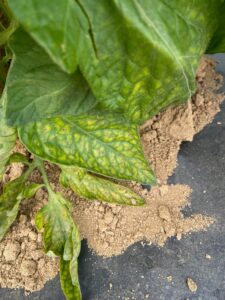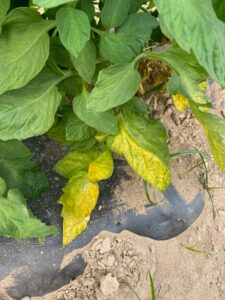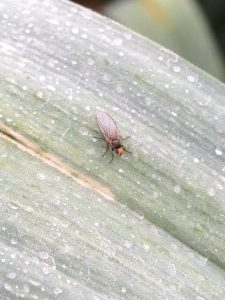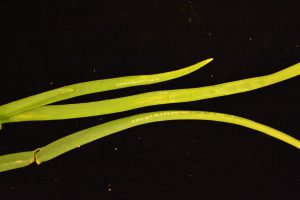Botrytis, or gray mold, caused by the fungus, Botrytis cinerea, can cause significant losses in high tunnel and greenhouse tomato production if not controlled properly. The pathogen can rapidly spread during periods when structures are closed and when relative humidity remains high for long periods of time. This often occurs when outside weather remains cool and damp while heating is needed. Gray mold is favored by temperatures from 64° to 75°F and requires only high humidity (not leaf wetness) to become established. The pathogen has a large host range and once established in an enclosed structure it can be very difficult to control (UMASS). The fungus can survive/overwinter as mycelia or sclerotia in plant debris and in organic soil matter (NCSU).
Identifying and controlling Botrytis in high tunnel and greenhouse tomato production
Identifying and controlling leaf mold in high tunnel & greenhouse tomato production
Leaf mold occasionally appears in high tunnel or greenhouse tomato production in New Jersey. However, under ideal conditions the disease will develop in field-grown crops. The fungus will cause infection under prolonged periods leaf wetness and when relative humidity remains above 85%. If relative humidity is below 85% the disease will not occur. Therefore, the proper venting of high tunnels and greenhouses on a regular basis is important. The pathogen can survive (overwinter) as a saprophyte on crop debris or as sclerotia in the soil. Conidia (spores) of the fungus can also survive up to one year in the soil.
Magnesium Deficiency in Tomato and the Relationship with other Important Nutrients
How can growers prevent nutrient deficiencies in crops? Soil testing and tissue testing for fertility management of vegetable crops is key to having the correct levels of nutrients to have a high yielding, high quality crop to harvest and market. Soil testing is best done in fall so that pH levels can be adjusted with soil amendments like lime that correct pH levels for maximum return on fertilizer uptake. Why adjust pH to proper levels? Plant nutrients are hindered in availability when soil pH is too high or too low. Besides pH, fertility levels are important to monitor and adjust pre-plant for the best start to new seedlings and transplants.
With tomato production it is widely known that calcium (Ca) levels in soil are important for prevention of blossom end rot. Therefore, tomato growers have focused on application of adequate and even high levels of calcium to prevent this fruit disorder. Another primary nutrient, potassium (K) is also important for plant and fruit quality for regulating water movement/water loss in the plant and other functions. In addition, it is important to also pay attention to magnesium (Mg) levels. Ca, K, and Mg are all important in successful tomato production. It is important to know these nutrients compete with each other for plant uptake and their proper levels based on soil and tissue testing.
Even though blossom end rot resulting from Ca deficiency can cause tomato fruit to be unmarketable, Mg deficiency can reduce overall plant health and ultimately quality and yield. Low K in the plant can make the plant less tolerant of heat and drought stress. Magnesium in tomato plants plays an essential role in photosynthesis (the process of the plant to make energy to fuel growth), protein synthesis (necessary in cell formation), activation of plant enzymes (necessary for many cellular and growth functions), and chlorophyll synthesis (the green pigment in plants that is essential for optimum plant growth).
Magnesium deficiency can occur, especially in sandy soils, when soil is overwatered or after heavy rainfall events. However, when Ca and Mg levels are out of balance, deficiencies can still occur even when both are showing adequate levels in the soil. It is more important to look at the actual levels. If one is significantly higher than the other deficiency symptoms may occur. Since both Ca and Mg are +2 ions in soil when taken up by plant roots, the plant indiscriminately takes up these two nutrients. Therefore, if there is abundant Ca and lower Mg, Mg deficiencies may be seen. Conversely, when Mg levels are higher than Ca levels blossom end rot may be seen. It is best to have these two nutrients in soil at the same levels to keep a balance in uptake and ultimately promote both healthy fruit formation and foliage growth. Allowing Mg levels to remain deficient in the plant will result in lower yields and less energy for fruit production later in the plants lifecycle.
Magnesium deficiency is first seen on tomato plants as interveinal chlorosis – yellowing of leaf tissue between the veins of older leaves. Eventually the leaves become mostly yellow and purplish-red spots that become necrotic on the interveinal tissue may occur. See photos taken in the 
 field on June 7, 2023.
field on June 7, 2023.
Deficiency symptoms can be seen at any stage of growth, but are generally first seen when plants begin to flower, start fruit set, and fruit enlargement. When plants change from vegetative growth (production of leaves and stems) to reproductive growth (flowering and fruiting) leaves are stressed and energy and resources are reallocated into growth and development of new progeny (seed and fruit).
Fortunately, Mg deficiency is easily corrected when caught early in the tomato plant’s growth by the application of Epsom salts. Rates differ depending on soil type, soil levels, and plant tissue levels. Mg rates can vary from 5-25 pounds per acre. Application can be done through drip irrigation systems or applied on the soil surface by spraying near the rootzone. When applying through the drip tape, be sure to run the lines with clean water for at least 20 minutes after the salts have gone thorough to prevent salt build up in the emitters. Foliar applications of Mg can be sprayed on plants, but are not as efficient as soil application and root absorption. There are other products available to correct low levels of Mg, but most data available for the use of Epsom salts to raise Mg levels. Pre-plant, the use of high Mg liming products can balance Ca and Mg levels in soil if Mg levels are lower than Ca levels. Therefore, when lime is needed to raise pH it is very important to look at Ca and Mg levels on the soil test results before selecting which type of lime will work best for adjusting the levels of these two very important plant nutrients.
When managing fertility levels for successful crop production, it is important to know the levels of plant nutrients in soil and tissue tests. It is as important to understand the interactions between plant nutrients and how they affect plant growth. Seeing an “optimum” or “sufficient” level on a soil or tissue test report is not enough to fully determine what is needed for high yielding, high quality crops.
Allium leaf miner update: 04/06/23
Allium Leaf Miner (ALM)
Allium leaf miner feeding and egg laying injury was discovered on chives and garlic near Milford in Hunterdon County on Wednesday. All weather stations on the NEWA network except for a few in the highest elevation sites in northern New Jersey have surpassed 250 growing degree days (GDD) base 39˚F. 39˚F is close to the lower developmental temperature (38.3˚ F) which our colleagues at Penn State recommend for predicting the first emergence of ALM adults. In recent years, initial feeding/egg laying scars have been detected within a few days of local weather stations recording the 250 GDD threshold. Growers who feel they may be impacted by this pest should check the accumulated GDD from local weather stations. Growers in southern counties may reasonably assume there will be ALM activity in their area soon, if not already happening. To determine GDD from local weather stations, the NEWA website https://newa.cornell.edu/ is very helpful. From the NEWA home screen, select the nearest weather station from drop down menu at the center of the page. Next, scroll down to “Weather Tools” on the right side of the page, and select “DD Calculator”. Select your start date (1/01/23) and end date as well as Degree Day Type (39 F) from the menu at the left of the page. The site will automatically generate the accumulated GDD base 39F to the last day of your requested sample, and then offer a forecast of accumulated GDD for the next week.
Growers should consider initiating the control method of their choice at this time. Affected crops include chives, scallions, garlic, onions and leeks. Look for neat rows of white spots descending from the upper tips of allium leaves (see photo at left). Initial injury often occurs on the tallest leaves. Under warmer, less breezy conditions, adults may be seen near the tips of leaves (see photo of adult at lower right). Perennial chive beds are often the first, and most heavily infested alliums of the spring season, so this makes chives an ideal crop to confirm ALM adult activity. At the Milford site this week, chives had feeding/egg laying scars on nearly 30% of leaves. The garlic field, which was approximately a half mile away, exhibited only 2% infested plants. A primary reason for this lower infestation rate in the garlic is that allium crops had not been grown in that field for several years.
Floating row covers, kept on until this flight ends will help minimize access to plants. Insecticide applications targeting adults may be helpful as well, although frequency of applications is uncertain. Spinosyn materials (Radiant, Entrust (OMRI approved)), pyrethroids (Mustang Maxx,  Warrior), neonicotinoids (Scorpion, Venom), the diamide Exirel (section 2ee recommendation) and the insect growth regulator Trigard are labeled for miner control.
Warrior), neonicotinoids (Scorpion, Venom), the diamide Exirel (section 2ee recommendation) and the insect growth regulator Trigard are labeled for miner control.
Adult activity and observations of feeding will be reported on in the IPM Update as they occur.
Allium leaf miner update: 03/09/23
Allium Leaf Miner (ALM)
Allium leaf miner feeding and egg laying injury was reported on chives in southern Cape May County on Thursday. The West Cape May weather station (closest station) has recorded 295 growing degree days (GDD) base 39˚F as of Thursday. 39˚F is close to the lower developmental temperature (38.3˚ F) which our colleagues at Penn State recommend for predicting the first emergence of ALM adults. 295 GDD at this temperature is in excess of the 250 GDD base 38.3˚ F that is the threshold for adult emergence and activity. In recent years, initial feeding/egg laying scars have been detected within a few days of local weather stations recording the 250 GDD threshold. Growers who feel they may be impacted by this pest should check the accumulated GDD from local weather stations. Growers in southern counties may reasonably assume there will be ALM activity in their area soon, if not already happening. To determine GDD from local weather stations, the NEWA website https://newa.cornell.edu/ is very helpful. From the NEWA home screen, select the nearest weather station from drop down menu at the center of the page. Next, scroll down to “Weather Tools” on the right side of the page, and select “DD Calculator”. Select your start date (1/01/23) and end date as well as Degree Day Type (39 F) from the menu at the left of the page. The site will automatically generate the accumulated GDD base 39F to the last day of your requested sample, and then offer a forecast of accumulated GDD for the next week.
Growers should consider initiating the control method of their choice at this time. Affected crops include chives, scallions, garlic, onions and leeks. Look for neat rows of white spots descending from the upper tips of allium leaves (see photo at left). Initial injury often occurs on the tallest leaves. Under warmer, less breezy conditions, adults may be seen near the tips of leaves (see photo of adult at lower right).
Floating row covers, kept on until this flight ends will help minimize access to plants. Insecticide applications targeting adults may be helpful as well, although frequency of applications is uncertain. Spinosyn materials (Radiant, Entrust (OMRI approved)), pyrethroids (Mustang Maxx,  Warrior), neonicotinoids (Scorpion, Venom), the diamide Exirel (section 2ee recommendation) and the insect growth regulator Trigard are labeled for miner control.
Warrior), neonicotinoids (Scorpion, Venom), the diamide Exirel (section 2ee recommendation) and the insect growth regulator Trigard are labeled for miner control.
Adult activity and observations of feeding will be reported on in the IPM Update as they occur.
Identifying and controlling Botrytis in high tunnel and greenhouse tomato production
Botrytis, or gray mold, caused by the fungus, Botrytis cinerea, can cause significant losses in high tunnel and greenhouse tomato production if not controlled properly. The pathogen can rapidly spread during periods when structures are closed and when relative humidity remains high for long periods of time. This often occurs when outside weather remains cool and damp while heating is needed. Gray mold is favored by temperatures from 64° to 75°F and requires only high humidity (not leaf wetness) to become established. The pathogen has a large host range and once established in an enclosed structure it can be very difficult to control (UMASS). The fungus can survive/overwinter as mycelia or sclerotia in plant debris and in organic soil matter (NCSU).


